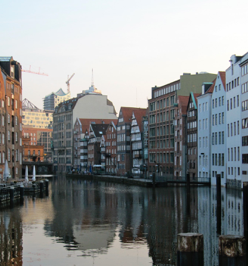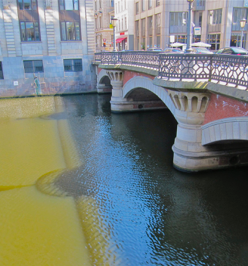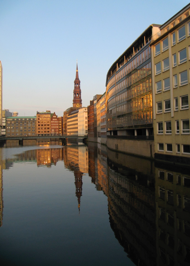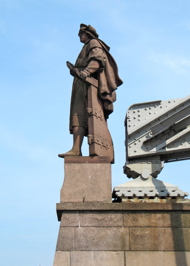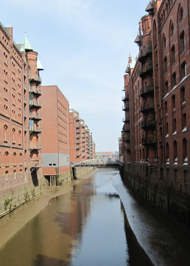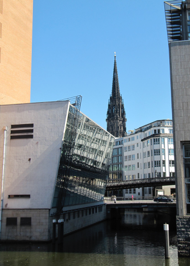CANALS
hamburg, Germany
northern europe
july 30 - August 6, 2011


CANALS
hamburg, Germany
northern europe
july 30 - August 6, 2011


Hamburg is known as a city of canals, with more canals that Amsterdam and Venice combined; and, with more than 2400 bridges crossing streams, rivers, and canals, the city can boast it has more bridges than London, Amsterdam and Venice combined. In our travels around the world, Henry and I have enjoyed many cities traversed by canals including Copenhagen, Venice, Amsterdam, Bruges, Avignon, Narbonne, and St. Petersburg. With that in mind, a little research revealed some interesting notes about canals:
The first canal in Europe, Italy’s Naviglio Grande, built in 1177 near Milan, was considered to have been the largest engineering project undertaken during the Middle Ages. In 1398, Germany built the first summit level canal, connecting the Stecknitz and Devanu rivers with more than 17 wooden locks along its 94 km/58 mile length. In France c. 1642, Maximillien de Bethune developed the Briare canal to reduce food shortages during the reign of Henry IV. In 1681, the Langeudoc Canal, renamed the Canal du Midi in 1789, was considered to be one of the greatest construction works of the 17th century. At 193 km/120 miles long, it connects the Atlantic Ocean to the Mediterranean Sea. These canals proved to be a more efficient mode of transport than handcart or wagon. The first modern canal was built in England in the late 18th century by the Duke of Bridgewater from the Worseley Mines to Mersey and was the first canal lined with a watertight clay to support the retention of water. When Peter the Great developed St. Petersburg as a capital city during the 18th century, canals were used to connect the navigable rivers. The Kiel Canal opened in Russia in 1785 connecting the North Sea with the Baltic Sea. The canal’s channel was 100 feet wide but only ten feet deep and could transport ships up to 120 tons. The engineering of canals during the period from 1760 to 1840 became the “Golden Age of Canals” made popular during the Industrial Revolution. During this period, factories were fed coal, stone, iron, copper, lime, sand, manure, and agricultural products for their fabrication. Canals supported the factories’ production, and brought food to feed the large workforces. America’s first three canals, the Dismal Swamp Canal in Virginia, the Santee Canal in South Carolina, and the Middlesex Canal in Massachusetts were built before the War of 1812; and, the Erie Canal, constructed between 1817 and 1825 in New York State, became the first canal project to be built with public bonds. Both New York City and New Orleans have streets today named “Canal Street”, built on the site of former canals. Between 1816 and 1840, nearly 3,500 miles of manmade canals were constructed in the USA in states such as Pennsylvania, Ohio, and New York.
Canals in both Europe and in America ended with the creation of the railroads that provided a more dependable means of transport. The delight of Hamburg’s canals finds beautiful architecture reflected in water, with restaurants and cafés offering tables outdoors overlooking the waterways. Water is very much a valuable aesthetic feature in beautiful Hamburg!
PHOTOS: Top Three: 1. The Rodingsmarkt area in the center of Hamburg along the Alster Canal. Modern buildings frame the steeple of St. Nikolaikirche. 2. Pulverturmbrücke over the Alster Canal in the Rodingsmarkt area of Hamburg. 3. Henry on the promenade along the Alster Canal near the center of Hamburg. Middle Three: 1. Neo-Gothic warehouse buildings, the largest complex of warehouse buildings in the world, line the canals around the Custom House and Hamburg Port Authority. 2. Adolphsbrücke spanning the Alster Canal near the Rathaus of Hamburg. 3. The steeple of St. Michael’s /St. Michchaeliskirche as seen from the perspective of the Herren-grabenfleet canal. Bottom Three: 1. View of the warehouse area built around the Zollkanal of the Custom’s House. The copper turrets are in a Neo-Gothic style topping massive red-brick buildings. 2. Half-timbered houses along the Alster-Hafen or Alster Canal in Hamburg. 3. Sculpture adorning the Brandsweite Brücke, 19th century bridge that replaced a former 14th century private passageway known, according to a document dated 1327, as the “Twiete von Herr Brandt.”

Waterways

